Next-Gen Product Packaging Trends You Should Know In 2025
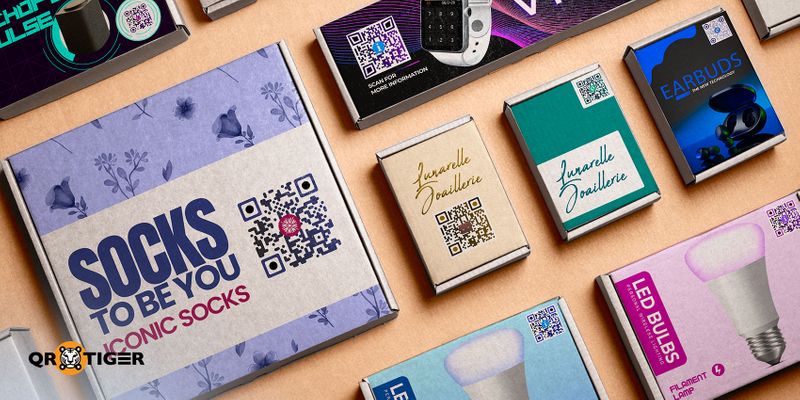
Consumer behavior changes every minute, spurring product packaging trends to emerge and evolve to deliver value and brand-new experiences to consumers.
Packaging is the first physical interaction a customer has with any product. People will always gravitate toward it when the packaging resonates with their preferences and values and suggests quality, care, and trust.
Since every interaction counts, brands of consumer packaged goods (CPG) worldwide are quick to adapt to these trends. And you should, too.
We’re exploring 13 packaging designs making waves in 2025, centering around social appeal, brand integrity, and sustainable practices.
Table of Contents
13 innovative product packaging trends to upgrade to in 2025
First impressions matter. A creative, high-quality packaging that instantly communicates value can change the outlook of your product.
Here are trending product packaging ideas every brand owner should know:
1. Smarter packaging with QR codes
The packaging industry trends show a strong shift toward storytelling, and digital tools like QR codes prove to enhance interactivity, traceability, and consumer engagement.
Here is how QR codes are helping brands deliver better, more interactive experiences:
- Product authentication and transparency: By scanning the QR code, customers instantly verify if a product is genuine and trace its origin.
- How-to videos and demos: Instead of relying on long printed instructions, brands use QR codes to redirect users to short videos that demonstrate how to use their products.
- Personalized rewards and royalty programs: Businesses use QR codes to direct their customers to time-sensitive promotions, points-based rewards, and geo-targeted offers.
- Augmented reality experiences: QR codes can trigger AR features that let users visualize products in their environment, play games, or explore interactive 3D storytelling.
- Sustainability and recycling information: With a quick QR scan, brands can lead customers to localized recycling guidelines, explain the materials used, or share a brand’s environmental efforts.
Consumer product packaging today must go beyond shelf appeal—it should communicate value, offer convenience, and connect digitally, which is possible with QR codes.
2. Pastel gradients
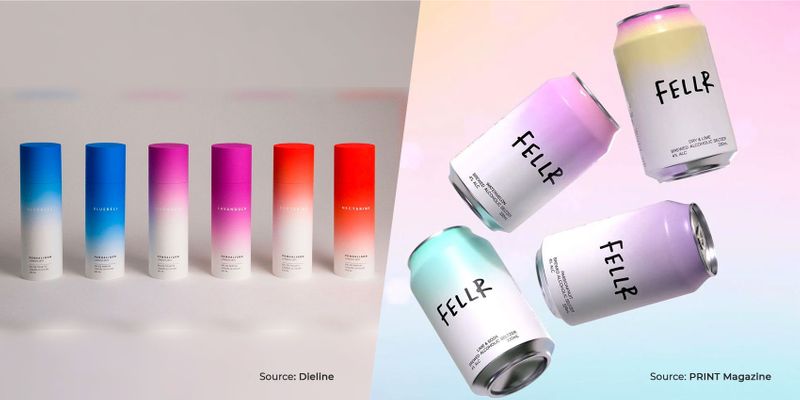
Pastel gradients are one of the colour trends for packaging and product design in 2025. They are being used by many skincare, wellness, and some food and beverage brands, particularly those targeting Gen Z consumers.
The British perfume house Penhaligon employs blue, magenta, and red-to-white gradients for its packaging, which is an interesting change for the vintage brand to adapt to contemporary times.
Designer Qinglu Guo aims for consumers to easily determine fragrances and concentrations, even as non-professionals, just through the arrangement of gradations.
FELLR’s seltzer (sparkling alcoholic water) cans, designed by Tom Schwaiger, also feature a soft pastel gradient that transitions gently across colors, creating an approachable and refreshing look.
Here’s why pastel gradients for packaging work:
- Softly distinctive: Pastels stand out with gentle elegance, offering relief among bold primary-colored products.
- Emotionally resonant: Pastel tones evoke calm, softness, and freshness, which is perfect for beauty, wellness, or food items.
- Modern and digital-native: Gradient effects mirror contemporary digital aesthetics and appeal strongly to younger audiences.
- Aesthetic flexibility: Whether a smooth sunrise gradient or a subtle pastel blend, these designs carry brand messaging with minimal graphics.
3. Classic and bold branding
The classic and bold product packaging design never goes out of style.
Have you noticed Heinz’s ketchup’s packaging labels? They have clear font styles that serve as a logo, bold colors, and visual hierarchy. It is clearly designed for quick recognition and brand legacy in mind.
Coca-Cola also leans into tradition while subtly modernizing over time by adding QR codes on bottles and cans.
Even when the packaging has changed shape over the years, these brands are able to maintain their longstanding visual identities.
What a classic and bold packaging signals to consumers:
- Trust: The packaging becomes a symbol of reliability, may it be in quality, safety, or emotional loyalty.
- Consistency: Preserves the core brand image, which reinforces its quality or performance.
- Bold personality: Have confidence in the product without the need for overwhelming graphics.
4. Clean and minimalist
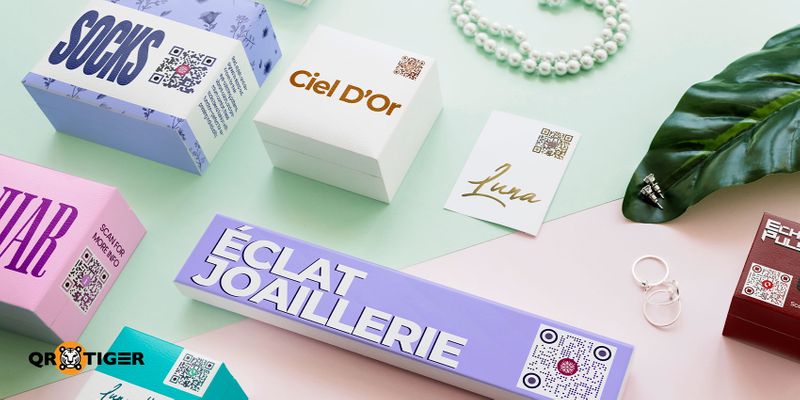
As they say, less is always more.
Brands embrace simplicity and clarity by going for clean and minimalist packaging designs. It lets the product and brand speak for themselves by removing the clutter.
It also pairs well with eco-friendly design practices like using less ink, fewer components, and recyclable options.
A clean and minimalist design features:
- Limited color palettes (often neutrals, monochromes, soft or bold tones)
- Ample white space
- Simple typography (sans-serif fonts)
- Few to no graphics or decorative elements
- Clear hierarchy of information
MUJI, The Ordinary, and Apple are some of the best brands that execute this design approach. Their minimalist designs stand out by calming the visual noise and highlighting their brand and product.
🎨 Design Tip: QR codes complement minimalist packaging designs. It keeps the packaging free from clutter while also giving it a digital dimension, allowing customers to interact with the brand online.
5. Dopamine design
Quite the opposite of the clean and minimalist product packaging trends, the dopamine design (other sources refer as ‘dopaminergetic’) is a packaging aesthetic that immediately triggers emotional reward.
This graphic design trend uses bright neon colors, eye‑popping shapes, playful fonts and energetic imagery that feels like TikTok made physical products.
Popular instant noodle brand Goodles uses this trend. Their packaging consists of neon‑loud, expressive packaging: vivid color palettes, playful type, cheeky snack imagery.
Similarly, Omsom, Asian pantry staples, are packaged in bold, saturated hues with dynamic, fluid typography that reflects rich flavors and cultural energy.
🎨 Design Tip: Use an HTML5 QR Code Generator to create a landing page QR for your dopamine-oozing packaging design. Letting customers win a reward after finding it improves their perception of your brand.
6. Bold typography
Imagine a bold, conversational typography. A food packaging that contains oversized ingredient lists or cheeky taglines. Such designs transform packaging into a direct dialogue with consumers.
RXBAR is the best example of that.
Fitness enthusiasts carefully examine the ingredients before purchasing their products. Keeping up with this intention, RXBAR packaging uses large, honest front-text to communicate core ingredients (egg whites, dates, and nuts) with clarity and impact.
Oatly also uses oversized, bold fonts for its witty copy on its carton packaging to drive brand voice. Pipcorn also does the same with its heirloom snacks packaging.
A strong typography:
- Delivers quick understanding to consumers.
- Strips away clutter and enhances distinction in crowded shelves.
- Reflects honesty and simplicity.
By making the typography the hero, the packaging is able to communicate the brand’s personality and values at first glance.
7. Story-driven packaging
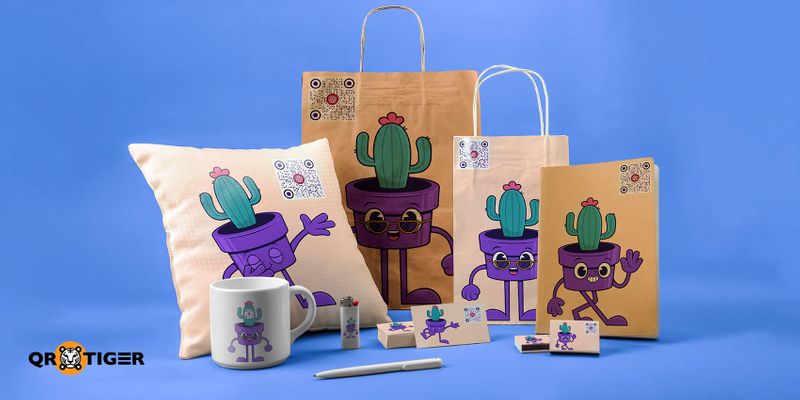
Who doesn’t love a good cartoon?
Trends in packaging include digital storytelling, emotional appeal, and interactive design, driven by rising consumer expectations.
Cartoon characters are playful illustrations that are able to turn packaging into an entertaining experience. This trend taps into youth culture, but still accommodates the “grown-ups,” making products shareable and fun.
KitKat, in collaboration with Google, introduced limited-edition packs featuring mascots. They even added a QR code on the pack linked to curated YouTube mini-series across sports, comedy, music, and gaming.
Zepto’s smart packaging twist is also something new to the eye. You can find doodles on Zepto QR code packaging that reflect people’s daily lives, nostalgic childhood memories, or activities celebrating tradition.
They feature a QR code that, when scanned, leads users to an augmented reality (AR) experience, as if the doodles on the delivery bags come alive.
🎨 Design Tip: Enhance customer engagement by creating a video QR code and placing it on the packaging. It will allow users to instantly watch tutorials, brand stories, or product demos with a quick scan.
8. Retro or vintage
One of the packaging mega trends that appeal to the new generation of consumers are—believe it or not—vintage-inspired designs.
These designs are all about reviving classic design elements like vintage fonts, color palettes, or packaging shapes.
It’s a good idea to use a retro or neo-vintage packaging if your brand aims to:
- Tap into emotional storytelling or retro lifestyle vibes
- Communicate heritage, artisanship, or quality
- Stand out with a timeless-yet-trendy look
Fishwife’s tinned fish products and Cadbury’s reissue of vintage Dairy Milk tin packs channel such nostalgic vibes effectively.
By having the mid-1990s packaging style, the brands are able to evoke memory and trust to consumers.
9. Loud greens
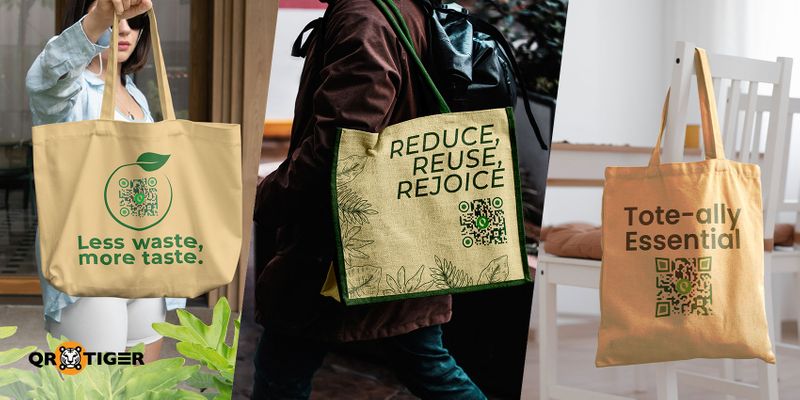
Sustainability is not a concept alone. Emerging packaging design trends focus on eco-responsibility, interactivity, and storytelling to capture consumer attention and loyalty.
Brands are travelling leaps and bounds to keep their products eco-friendly. Packaging is one of the key elements that they focus on to keep their commodities green.
The common sustainable packaging innovations are:
- Biodegradable, compostable, and plastic-free packaging
- Refillable and reusable packaging
- Packaging made from recycled materials
Some brands already making the initiative toward greener consumerism are Seventh Generation, Lush, Alter Eco, and By Humankind.
QR codes on bottles, cans, and containers are among the food packaging trends that food and beverage companies adopt to encourage recycling and reduce the frequency of irresponsible waste disposal.
Some organic gluten-free product packaging, like the ones by One Degree Organics, features a QR code that links to videos and stories about the farmers behind the ingredients, effectively connecting consumers to the origin of each component.
Companies are also avoiding printing a thousand pages of product manuals, which is costly and environmentally hazardous, by simply adding a PDF to QR code on packaging.
Such initiatives highlight that companies are becoming more socially and environmentally responsible, increasing the customer base patronizing sustainable brands and products.
10. Design rooted in culture
Packaging may represent culture and connect deeply with authenticity. This trend turns a product into a cultural ambassador.
For instance, Mezcal Barajas features traditional Mexican motifs on hand-painted bottles, merging artisanal craft with visual storytelling.
As part of its Habi (weave) series, Tisyu, a Filipino brand, also highlights traditional patterns on facial tissue boxes. This subtly showcases the country's colorful culture.
🎨 Design Tip: Adding a QR code to your cultural design can transport consumers into the world behind the package. Brands can share artisan interviews, production footage, or regional history, enriching brand credibility and consumer connection.
11. Moodboard magic
Innovative product and food packaging designs now blend visual appeal with functionality, offering freshness indicators, resealable features, and scannable QR codes for recipes or sourcing information.
Some designs feel like curated collages or Pinterest boards. They have layered shapes, abstract forms, and harmony of colors. It’s visually engaging and emotionally expressive.
These combine vibrant gradient ribbons with minimal typography for a modern collage effect.
12. Fruit pop
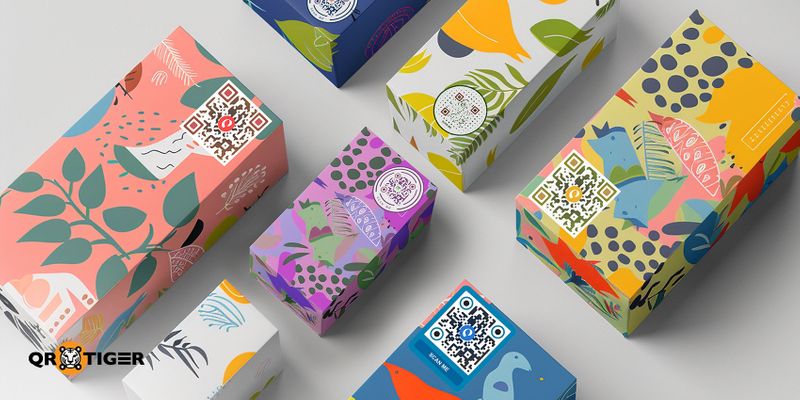
One of the most fun product packaging trends is the “Fruit Pop.”
It embraces juicy, eye-catching color palettes that channel the vibrant hues found in nature’s most delicious produce.
Imagine shades like lime greens, watermelon pinks, orange citrus, and blueberry blues. Punchy tones such as these will evoke a fresh, youthful energy that stands out on crowded shelves.
In 2025, the fruit pop trend also pairs well with transparent packaging or frosted finishes, giving the illusion of freshness and naturalness without sacrificing boldness.
For instance, Poppi Soda uses vibrant fruit-inspired shades that match their flavors, such as orange for orange, blush pink for raspberry rose, and teal for classic cola with apple cider vinegar. This colour coding can help customers recognize the drink quickly.
13. Creative chaos
This trend celebrates the handmade, the imperfect, and the proudly small-batch. It is a counterpoint to overly polished, mass-produced packaging.
Trends like these embrace doodles, collage-style visuals, uneven brushstrokes, torn paper textures, and bold handwritten fonts.
When customers hold such a product in their hands, they feel that what they’re having is special and personal, crafted with care rather than churned out by a machine.
International brands like Tony’s Chocolonely use clashing color combos and jarring layouts to reflect their "unequal" chocolate bar pieces.
How to create a QR code for packaging
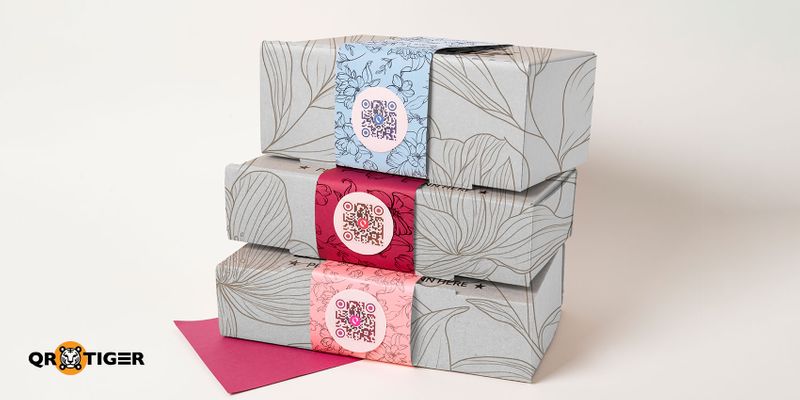
Changing trends in packaging and various products are driven by consumer behavior shifts, digital access needs, and sustainable demands.
By 2027, businesses and brands worldwide are expected to have a QR code on packaging for delivering valuable content and more efficient tracking. Learn how to create one for your products by following these steps:
1. Open a QR code generator with logo integration.
2. Choose a QR code type and enter the information.
3. Select ‘Dynamic QR code’, then generate.
4. Customize the code with your brand logo, colors, and design.
5. Download your QR code.
Reminder: Make sure to test your QR code before downloading, printing, or using it.
QR code placement ideas for smart packaging
Here are some QR code placement ideas that can be used on product packages:
1. Front panel
QR codes can be placed on the front panel for maximum visibility. It ensures that the code is instantly visible, and encourages engagement right at the point of purchase.
This is ideal for promotional campaigns, discount codes, or limited-edition product reveals.
2. Side or back panel
The side or back panel of a product is perfect for QR codes that link to ingredient lists, usage instructions, or certification details.
It will help in keeping the front part clean while still offering rich content to engaged buyers.
3. Inner packaging
You can add QR codes inside the box, label, or product flap to surprise customers with exclusive content.
For instance, you can add user manuals, tutorials, or loyalty rewards inside the inner packaging.
It encourages interaction after purchase and helps build brand loyalty.
4. Hang tags or stickers
You can attach QR codes on hang tags, or even place a QR sticker on a custom bottle, jar or pouch.
This gives you flexibility in placement and allows you to test campaigns without changing your main packaging design.
5. Peel to reveal labels
You can hide QR codes under peel-back labels or layered stickers. Add a CTA, “peel for surprise gift”, to make the buyer curious.
This tactic is entertaining and can reveal interactive content like AR experiences, hidden discounts, or brand storytelling.
Brands with brilliant QR code packaging designs
Beyond attractive packaging that shapes brand identity, some brands are stepping up by integrating creatively designed QR codes—enhancing both the visual appeal and interactive potential of their packaging.
Valentim’s yogurt bottles
Valentim – Iogurteria Artesanal, a Brazilian artisanal yogurt brand, has turned the humble QR code into a delightful, artful surprise. They really stepped out of the box with the Valentim Kids packaging.
The brand integrates illustrative QR codes that blend seamlessly into its playful packaging visuals.
When scanned, kids can download illustration packs featuring Valentim and pals using which they can print, colour and play, turning product packaging into an artistic activity.
Coca-Cola’s interactive cans
Coca-cola’s share a coke campaign features personalized cans with QR codes that link to interactive digital experiences.
Consumers can scan the QR codes on the cans to access a customization platform where they can add their own personal touches, like names or nicknames, to the Coca-Cola packaging.
Jameson’s box of whiskeys
As part of the Jameson Black Barrel Father’s Day campaign, they introduced QR codes on their packaging.
By scanning the code, the customer will be directed to an AI song-creation page, where they can choose a music style and tone of memory.
Based on the details entered, AI creates a custom song that they can share and replay.
Maybelline’s virtual try-on
Maybelline integrates QR codes on packaging and promotional displays that direct users straight to its Virtual Try-On tools.
This feature, which uplifts the shopping experience, is powered by ModiFace AR technology from L’Oréal.
It enables the shoppers to try on lipstick, foundation, eye makeup, and more through their smartphone cameras or uploaded selfies.
Four Peak’s recycling initiative
Four Peaks Brewing Company is the first beverage company to incorporate a digital location-based recycling tool through a QR code on all their packaging.
By implementing these innovative technologies, Four Peaks is taking a proactive stance on environmental responsibility, designed to boost consumer recycling efforts and delicious brews.
Keep up with the packaging trends
Smart product packaging trends will continue to emerge and evolve as consumer demands change.
Keeping up with the trends while maintaining your brand identity is
A dynamic QR code generator, will let you create QR codes that can track data scans and update your code without reprinting it.
FAQ
What are the future trends in packaging?
The future of packaging is shaped by sustainability, smart technology, and personalization.
Brands are moving toward eco-friendly materials like biodegradable plastics and recycled content and smart tools like QR codes are helping them to meet their goals.
What are the 4 C's of packaging?
The 4 C’s of packaging are Content, Containment, Convenience, and Communication.
- Content: Ensuring the package safely holds the product.
- Containment: Maintaining product integrity during storage and transit.
- Convenience: Making the product easy to use, open, carry, or dispose of.
- Communication: Conveying the brand message, legal info, and engaging with customers through design and technology like QR codes.
What are the packaging trends for 2025?
In 2025, packaging trends mainly focus on sustainability, digital integration, and consumer engagement.


